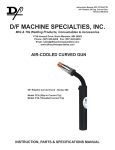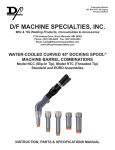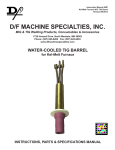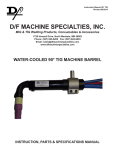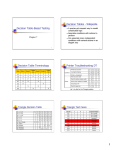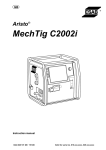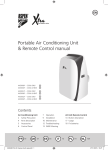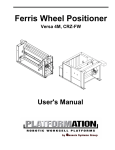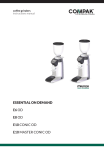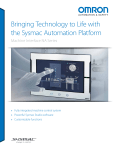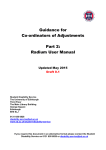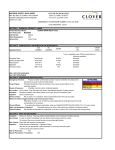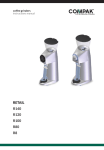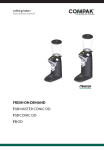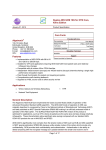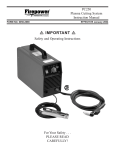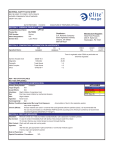Download Instruction Manual 252 Air-Cooled Pistol Gun
Transcript
Instruction Manual 252 PAC/PAT Air-Cooled Pistol Revised 06/2014 D/F MACHINE SPECIALTIES, INC. MIG & TIG Welding Products, Consumables & Accessories 1750 Howard Drive, North Mankato, MN 56003 Phone: (507) 625-6200 Fax: (507) 625-6203 Email: [email protected] www.dfmachinespecialties.com AIR-COOLED MIG PISTOL GUN MODEL PAC (Slip-In Current Tip) MODEL PAT (Threaded Current Tip) INSTRUCTION, PARTS & SPECIFICATIONS MANUAL D/F MACHINE SPECIALTIES is a world leader in the design, development, and manufacture of “MIG” (GMAW) & “TIG” (GTAW) welding products, consumables and accessories. D/F offers several types of manual Air or Water-Cooled “MIG” welding tools, and with the increased use of automated and robotic welding systems, a demand has been created for welding tools of the highest quality, durability and interchangeability. For over forty years, D/F welding products have been used extensively on “MIG” and “TIG” welding applications. This experience, coupled with patented design features, unavailable on any other competitive equipment, has made D/F welding tools the most advanced “MIG” and “TIG” welding guns and barrels for semi-automatic, automatic or robotic welding applications. This Catalog is a guide to helping you select the proper tool for a given semi-automatic, automatic or robotic welding application. The following is only a partial listing of available semi-automatic, automatic and robotic guns. For further information on special “MIG” and “TIG” requirements, please consult the factory. Customer satisfaction and customer benefits are the center points of all strategic contents The spirit of the D/F Machine Specialties personnel is to listen to and to integrate the customer throughout the process, to develop and design marketable products, to present prototypes, to carry out pilot tests and to prepare for and be open to new technology and tasks. We attract and carefully select talented individuals who share our values. Together we will nurture and sustain a work environment with two-way communication, training, mentoring, and rewarding career opportunities. Innovation and quality Innovation and quality come from being receptive and willing to learn from others. We encourage our people to be creative and take risks in the pursuit of excellence. Innovative practices are deeply rooted in every one of our employees, a philosophy that leads to continuous product development and industry firsts. Progress By remaining confident, focused, and persistent in challenging times, we will discover opportunity. Commitment to quality and the pursuit on innovation ensure that D/F Machine Specialties will remain an industry leader for years to come. Commitment to excellence At D/F Machine Specialties we commit to design, build and deliver premium products and superior customer support to quality driven welding professionals. Customers still to this day choose D/F over competitors because of our responsiveness and flexibility. Customers will continue to choose D/F tomorrow for our superior hand-made products and service. To ensure this, we need creative and competent personnel in all business divisions, an intensive exchange of thoughts and ideas with all users, participation in working and study groups within the field of welding technology and intensive cooperation with institutes and universities. Teamwork Striving for excellence is a commitment that is an integral component of the D/F Culture. Our team of skilled and dedicated employees takes pride in the excellence products they produce. Each of us willingly accepts personal responsibility for meeting our commitments and we hold each other to a high standard of accountability. Responsibility We will continually strive to be environmentally responsible and to support the health and safety of our employees, customers, and neighbors. We continue to support the communities in which we operate and the industries in which we participate. Thank You for Choosing D/F Machine Specialties TABLE OF CONTENTS Safety.............................................................................................................................4 Introduction, (Table 1) Ordering Information, (Table 2) Specifications, (Table 3) Recommended Spare Parts............................................................................5 (Table 4) Gas Nozzles, (Table 5) Current Tips...............................................................6 Disassembly, Assembly..................................................................................................7 Required Tools List for Disassembly & Assembly........................................................8-9 How Do I Cut, Fit, and Install a New Liner?.................................................................10 What is the Proper Use of the Nozzle Thread Chaser Tap?......................................... 11 Air-Cooled Pistol Gun - Parts.......................................................................................12 (Table 6) Liners, (Table 7) Casings, (Table 8) Switch & Cable Assemblies..................13 Utility Station - Air-Cooled Barrels................................................................................14 Wire Feeder Adapters..................................................................................................15 Troubleshooting.......................................................................................................16-19 SAFETY MEASURES - **PLEASE READ!** Welding is not particularly hazardous when certain safety practices are followed. Anyone using this equipment should be thoroughly trained in safe welding practices. Failure to observe safe practices may cause serious injury. Handling welding torches presents no danger if the appropriate safety regulations are strictly adhered to. For example: • Starting-up procedures must be reserved for those fully conversant with processes relating to arc welding equipment. • Arc welding can prove damaging to eyes, skin, and hearing! It is therefore imperative that the Accident Prevention Regulations UVV 26.0 and VGB 15 are fully observed and that all protective clothing, eye and ear protectors specified are worn. • The load data given are maximum limit figures. Overloading will inevitably damage the torch! • Before changing wear parts, disconnect for the power supply. • The operating instructions for the individual welding components - e.g. power source, wire feed and cooling unit must be followed. • Never pull the cable assembly across sharp edges or set down close to weld spatter or on a hot workpiece. • Those not involved in the welding process should be protected by curtains or partitions from radiation and the danger of being dazzled. • When handling gas cylinders, consult the instructions issued by the manufacturers and the suppliers of the pressurized gas. • Workpieces which have been degreased using chlorinated solvents must be sprayed down with clean water before welding starts to avoid the risk of phosgene forming. For the same reason, no degreasing baths containing chlorine must be placed close to the welding point. • All vapors given off by metals can cause harm and a special warning is attached to lead, cadmium, copper, zinc, and beryllium. If necessary, take appropriate precautions (by providing adequate ventilation or an extraction system) to ensure that the legal maximum levels of toxic concentrations are not exceeded. For more information, refer to the following standards in their latest revisions and comply as applicable. • ANSI Standard Z49.1, SAFETY IN WELDING AND CUTTING obtainable from the American Welding Society, 2501 N.W. 7th St., Miami, FL 33125. • ANSI Standard Z41.1, STANDARD FOR MEN’S SAFETY - TOE FOOTWEAR obtainable from the American National Standards Institute, 1430 Broadway, New York, NY 10018. • ANSI Standard Z49.2, FIRE PREVENTION IN THE USE OF CUTTING AND WELDING PROCESSES obtainable from the American National Standards Institute, 1430 Broadway, New York, NY 10018. • OSHA, SAFETY AND HEALTH STANDARDS, 29CRF 1910, obtainable from the U.S. Government Printing Office, Washington, D.C. 20402. • AWS Standard A6.0, WELDING AND CUTTING CONTAINERS WHICH HAVE HELD COMBUSTABLES obtainable from the American Welding Society, 2501 N.W. 7th St., Miami, FL 33125. • NFPA Standard 70-1978, NATIONAL ELECTRICAL CODE obtainable from the National Fire Protection Association, 470 Atlantic Avenue, Boston, MA 02210. • ANSI Standard Z88.2, “Practice for Respiratory Protection” obtainable from the American National Standards Institute, 1430 Broadway, New York, NY 10018. • ANSI Standard Z87.1, SAFE PRACTICES FOR OCCUPATION AND EDUCATIONAL EYE AND FACE PROTECTION obtainable from the American National Standards Institute, 1430 Broadway, New York, NY, 10018. • NIOSH, SAFETY AND HEALTH IN ARC WELDING AND GAS WELDING AND CUTTING obtainable from the Superintendent of Documents, U.S. Printing Office, Washington, D.C. 20402. • American Welding Society Standard AWSF4.1 “Recommended Safe Practices for the Preparation for Welding and Cutting of Containers and Piping That Have Held Hazardous Substances”, obtainable from the American Welding Society, 2501 N.W. 7th St., Miami, FL 33125. 4 INTRODUCTION These Air-Cooled Pistol Guns are offered as two different models. The Model PAC employs a slip-in tip fastened by a collet action nut. The Model PAT accommodates a threaded current tip. Various front end nozzle body arrangements are offered to cover a broad range of applications. Conversion to the use of a particular nozzle body arrangement is easily accomplished by selecting the desired nozzle body and current tip adapter arrangement. The Air-Cooled Gun assemblies operate on a current thru 400 amperes, contingent on the front end nozzle body being used, and the current tip. The Model PAC, with a slip-in current tip, operates on a current level thru 260 amperes. Model PAT, with a threaded current tip, operates on a current thru 400 amperes. The higher current levels would be obtainable with CO2 as the shielding gas. Gun assemblies will accommodate a wire diameter range of .030” thru 1/16” diameter. For further information or help with D/F Machine Specialties products, please visit our web site at www.dfmachinespecialties.com, or consult the factory at 1-507-625-6200. TABLE 1 - ORDERING INFORMATION CODE NO. MODEL LENGTH 11286 11287 11288 PAC-91 (Slip-in Tip) PAC-92 (Slip-in Tip) PAC-93 (Slip-in Tip) 10 Ft. 12 Ft. 15 Ft. 17776 17777 17778 PAT-76 (Th’d Tip) PAT-77 (Th’d Tip) PAT-78 (Th’d Tip) 10 Ft. 12 Ft. 15 Ft. TABLE 2 - SPECIFICATIONS MODEL PAC PAT CURRENT CAPACITY 260 amp CO2, 400 amp Argon 260 amp CO2, 400 amp Argon DIAMETER OF BODY HOUSING LENGTH WEIGHT (approx.) 1.625” 12.875” 2.5 lbs. 1.625” 12.875” 2.5 lbs. TABLE 3 - RECOMMENDED SPARE PARTS ITEM Gas Nozzle Current Tip Collet Nut Body Liner Insulation Tube Insulator CODE NO. To Be Selected To Be Selected To Be Selected To Be Selected To Be Selected 13163 MIN QTY. 2 25 1 2 1 1 5 RECOMMENDED WIRE DIAMETER RANGE .030”-.062” Hard/Cored 3/64”-1/16” AL .030”-.062” Hard/Cored 3/64”-1/16” AL TABLE 4 - GAS NOZZLES GUN MODEL NC/HT REF. 1 2 3 4 5 NOZZLE TYPE Copper Tapered Copper Straight Copper Full Taper Copper Straight Use With Nozzle Body 13198 1 2 O.D. 63/64” 1” 63/64” 5/8” 1-1/16” 3 CURRENT TIPS - 1/4” DIAMETER SLIP-IN All NC, NCC, NCM (Tip provides 1/8” set back) All NC, NCC, NCM (Bent Tip) (Tip provides 1/8” set back) Wire Size .030” .035” .045” .052” 1/16” 5/64” 3/64” 1/16” 5/64” 3/32” .045” .035” 3/64” 1/16” Wire Type Hard Hard Hard Hard Hard Hard Aluminum Aluminum Aluminum Aluminum Hard Hard Aluminum Aluminum Code No. 10787 10788 10789 10830 10790 10792 10781 10782 10823 10783 10562 10565 10572 10573 CURRENT TIPS - 7/16” DIAMETER THREADED Gun/Barrel Model All HT, HTC, HTM, CTW, CW-T, MTW (Tip provides 1/8” set back) All HT, HTC, HTM, CTW, CW-T, MTW (Tip provides 3/8” set back) All HT, HTC, HTM, CTW, CW-T, MTW (Tip provides 1/8” set back) Wire Size .035” .045” .052” 1/16” 5/64” 3/32” 7/64” 1/8” .035” .045” .052” 1/16” 5/64” 3/32” 7/64” 1/8” 3/64” 1/16” 5/64” 3/32” 1/8” Wire Type Hard Hard Hard Hard Hard Hard Hard Hard Cored Cored Cored Cored Cored Cored Cored Cored Aluminum Aluminum Aluminum Aluminum Aluminum CODE NO. 10362 10340 10359 10374 10379 4 TABLE 5 - CURRENT TIPS Gun/Barrel Model All NC, NCC, NCM (Tip provides 1/8” set back) I.D. 5/8” 3/4” 5/8” 7/16” 3/4” Code No. 15116 15117 15121 15118 15119 15120 15122 15105 15101 15106 15112 15107 15108 15109 15110 15111 15126 15125 15087 15148 15123 6 5 DISASSEMBLY 1) When repairs are made on the production line, make certain the power source and wire feeder are disconnected from primary power. 2) Remove forward gas nozzle. If threads are damaged or clogged up with spatter, use the nozzle thread chaser tap (14610) to recondition the nozzle body. 3) Remove the current tip with the wrench provided (12111) by loosening the threaded tip, or by loosening collet for a slip-in tip. 4) If the collet adapter (13205) or threaded adapter (12019) is to be replaced, proceed as follows. Unscrew the nozzle body. If the insulator threads off with the nozzle body it may be necessary to grip the edge of the insulator (13163) and turn it out. Do not apply excessive pressure to the insulator. The nozzle body insulator (16605) can be removed by sliding it to the rear. NOTE: Nozzle body (13197) insulator threads can be reconditioned and re-chased with the rear nozzle thread chaser tap (14612). 5) Remove the adapter by using two 5/8” wrenches, one to hold the jam nut (16202) and the other to unscrew the adapter. 6) The casing/liner assembly can be removed and replaced by simply loosening the internal locking screw which is visible through the hole located behind the inner body holding screw. 7) By removing the flat head inner body holding screw, the inner body with utilities connected may be pulled from the rear of the body tube. ASSEMBLY 1) If a new power cable is required, proceed as follows. Trim approximately 1” off of the cable covering. Carefully wrap the copper strands with the copper sheet. Slip the wrapped copper cable end with locking clip (16196) provided into the rear of the inner body cable adapter. Prior to applying the cable, place the heat shrink sleeve (12641) on the cable. 2) Securely tighten the socket set screws on the power cable assembly. Push the heat shrink sleeve forward so that after the heat is applied the cable/adapter is covered completely. 3) Carefully insert the inner body assembly into the body housing. Make certain that the electrical cable is in its locating pocket provided in the body housing. The flat head body holding screw may now be applied. 4) Check to make sure that your gun assembly has the right size current tip and liners for wire to be used. 5) When installing a new collet (11950) be careful not to over-tighten it with the collet wrench. Excessive pressure is not required due to the good gripping action of the collet. 6) Current tips and nozzles should be cleaned as frequently as required. A clogged gas nozzle will restrict the flow of shielding gases. 7) Check regularly the condition of the service hose and control wire connections leading from the wire feeder and power source. 7 REQUIRED TOOLS LIST FOR DISASSEMBLY & ASSEMBLY 1. D/F 12111 Collet/Tip Wrench - This is the only tool that should ever be used to tighten the collet nut or the tip. Pressure should be 30 lbs., or as snug as hand tightened. Never use another wrench to apply more torque to this wrench. 2. D/F Nozzle Thread Chaser Taps (Front & Rear) - This is used to re-tap damaged threads that have been improperly cleaned or cross threaded. Always blow out the nozzle and gas nozzle after changing gas cup or re-tapping. For more information on how to use the nozzle thread chaser tap, use the following link: www.dfmachine.com/taps 3. 3/8” Open Ended Wrench - This is used on the inner body’s gas hose fitting to secure the gas hose to the torch’s inner body. A crescent wrench could be used instead, but due to the large size of crescent wrenches, we prefer the smaller size of the open ended wrenches. You never want to use excessive force by using too large of a wrench. You will use the Long 7/16” Open Ended Wrench for the fitting on the gas hose itself while using the 3/8” wrench to steady the inner body at the fitting. (see #4) 4. Long 7/16” Open Ended Wrench - This is used to secure the gas hose to the torch’s inner body. (see #3) 5. 5/8” Open Ended Wrench - This wrench is used to secure the adapter and jam nut that hold the current tip to the inner body. In your left hand hold the inner body, and with your right hand thread up the adapter using the 5/8” Open Ended Wrench until it is tight. Now place the same wrench on the jam nut and snug it up against the inner body. Keeping that wrench on the jam nut and placing it on the table for force, take a second 5/8” Open Ended Wrench, place it on the adapter and push it down (counter-clockwise) securing the adapter to the inner body. 6. Adjustable Crescent Wrench - A medium size adjustable crescent wrench could be used as well. CAUTION: Never use excessive force with large wrenches, for you could twist or break parts. 7. Standard Flat Head Screwdriver - This is used to tighten or secure the torch’s body screw. Also, the screwdriver can be used to straighten the contact tip if it is not aligned in the center of the gas cup or water-cooled nozzle CAUTION: This cannot be done unless the spatter disc has been removed from the torch. 8. Small Narrow Flat Head Screwdriver - This is required to insert into the small body housing hole so you can access the casing/ conduit set screw. 9. Long Nose Pliers - These are very handy when changing a slip-in contact tip. 10.1/16” Allen Wrench - This is used for secure the button switch set screw in the aluminum pistol handle. 11. 3/32” Allen Wrench - This is used to secure the socket cap screws in the handle bracket to the 3 t-bolts required to secure the handle bracket (10338) to the body housing (12130). 12.7/64” Allen Wrench - This is used to secure the 4 socket cap screws in the sides of the aluminum pistol handle to the handle bracket and body housing. 13.5/32” Allen Wrench - This is used on the inner body’s set screws to secure the power cable to the torch’s inner body. 8 REQUIRED TOOLS LIST FOR DISASSEMBLY & ASSEMBLY 9 HOW DO I CUT, FIT, AND INSTALL A NEW LINER? 1. Be sure the MIG Gun cable is arranged in a straight line, free from twists, when installing or removing a wire liner. 2. Remove the old liner by first removing the MIG gun’s contact tip. 3. Pull the old wire liner out of the conduit/casing assembly from the feeder connector or feeder adapter plug end. If you are using a feeder adapter that has an inlet, the inlet must be removed first. If you have any problems removing the liner you may un-thread the feeder adapter first this will also back the liner out of the conduit/casing. 4. If you know that the old liner is the correct length or is still the original liner that was cut at the factory you may hold the new liner up against the old liner and cut off the new liner to the same size as the old liner. 5. Make sure you have a good sharp cut off with no material sticking out! 6. To get the correct length of the new liner, insert the liner into the feeder adapter and feed it through the conduit/casing. 7. Once again be sure the MIG Gun cable is arranged in a straight line, free from twists, when installing a new wire liner. 8. Sometimes on longer conduits/casings and liners it may take 2 people together; one on each end to rotate and twist the conduit/casing to get the liner trough the torch. 9. If you have any troubles getting a liner through a torch make sure you have a good sharp cut off, and if you have to you can gently sand the end of the liner on a belt sander. You can remove the cast in the aluminum liner by pre-bending and straightening the liner before loading. 10.After the new liner comes out the end of the torch you want to cut the new liner off flush with the end of the copper gas nozzle or Cu gas cup. 11. Now you have the overall length of the liner, you still have to take out the length of the contact tip. 12.Carefully remove the liner one more time. 13.After removing the liner hold the gun end of the liner up against the tip. 14.Cut off the length off the tip plus the set back of the tip (1/8” or 3/8” tip setbacks) 15.Now that you have cut off the length of the tip plus the setback you may install the new liner and it will back up into the back of the tip chamfer. 16.We always recommend checking the condition of the insulation tube in the front of the torch and collet nut that holds the slip-in tip. 17.We always recommend replacing the spatter disc/gas diffuser, contact tip, and nozzle, after installing a new liner. 18.Tighten the flat head set screw in the inner body, or the Allen set screw in the docking spool onto the conduit/casing to prevent backward movement or an unwanted pumping action. 10 WHAT IS THE PROPER USE OF THE NOZZLE THREAD CHASER TAP? All D/F Nozzles are hand checked for fit before and after plating, and checked again before shipping. If a nozzle has been installed on a new complete torch, they have also been hand checked while being assembled. The only reason to ever take a gas cup out a nozzle is to clean it. The nozzle and the gas cup must be blown out, and all of the threads have to be wire brushed and blown out again before hand-tightening the gas cup back into the nozzle. If you can’t thread it in by hand then something is wrong. Never force a gas cup into a nozzle. When using the D/F Machine Specialties nozzle thread chaser taps, be sure to always follow the steps below: 1. Make sure that the nozzle is properly supported when tapping so it does not twist in the front of the torch body and cause damage. • Improper support can cause the spigots to twist off the top of the rear nozzle collar, or damage the torch internal body parts. • Note where the water ports go down the sides of the water-cooled nozzle (following down in line with the spigots). Too much direct pressure on these water ports could cause them to cave in and block of the flow of water. • Best practice is to hold the water-cooled nozzle in a vice with soft jaws, perpendicular to the spigots. • Over-tightening of the vice can cause damage in general. 2. Remove the tip from the front of the torch before tapping. 3. Lightly lubricate the nozzle and nozzle thread chaser tap before tapping. 4. Be sure to start the tap very carefully. Do not cross thread the nozzle. 5. Be very careful to start threads correctly. Only tap 1/2 turn at a time, always backing up and removing chips 1/2 cycle at a time before moving forward. Do not try to tap further into the water-cooled nozzle than needed or past the factory thread depth. 6. Blow out the nozzle after tapping. Wire brush and blow off the gas cup before threading it back into the nozzle. 7. If nozzle is badly deformed or damaged please return to the factory for a repair estimate before disposing of product (damaged parts can often be repaired). ORDERING INFORMATION - NOZZLE THREAD CHASER TAPS CODE NO. DESCRIPTION USED WITH NOZZLE ASSEMBLY USED FOR GAS NOZZLE 14610 Nozzle Thread Chaser Tap for Standard A/C & W/C Nozzle Assembly Front 13197 16184 11117, 45101 11118, 45102 11119, 45103 45114 45107 NCC-N/HTC-N NCC-LRN, HTC-LRN 10340 10359 10362 10374 14611 Nozzle Thread Chaser Tap for BIG MIG & BIG TIG Nozzle Assembly Front 11123 10382 10387 10389 10390 10392 14612 Nozzle Thread Chaser Tap for Nozzle Body Assembly Rear 13196 13197 13198 16184 14614 Nozzle Thread Chaser Tap for Series A High-Capacity Nozzle Assembly Front 11142, 45120 11138, 45121 45127 11132, 45129 45125 16748 16749 16750 16751 18030 18031 18032 14615 Nozzle Thread Chaser Tap for Nozzle Body Assembly Front 13198 10379 14617 Nozzle Thread Chaser Tap for Tandem Nozzle Assembly Front 41641 41667 41668 11 AIR-COOLED PISTOL GUN MODEL PAC (Slip-In Tip) MODEL PAT (Threaded Tip) 40 8 39 1 6 7 11 12 4 5 13 38 9 33 10 3 2 31 32 14 15 13 16 34 17 18 19 25 26 23 20 24 28 21 29 27 REF. CODE NO. DESCRIPTION 16 17 18 19 12019 16605 13163 13176 13197 Adapter - Threaded Tip Internal Insulator Insulator Nozzle Body w/ Insulator Nozzle Body less Insulator Gas Nozzle (see Slip-In Current Tip (see p. 6, Table 5) Nozzle Body w/ Insulator Nozzle Body less Insulator Insulator - Gas Nozzle Gas Nozzle .540” ID Gas Nozzle .625” ID Nozzle Body w/ Insulator Nozzle Body less Insulator Gas Nozzle (see p. 6, Table 4) Threaded Current Tip (see p. 6, Table 5) Wrench Nozzle Thread Chaser Tap (front) Nozzle Thread Chaser Tap (rear) Heat Shrink Sleeve Cable Clamp Kit Switch & Cable Assy. (see p. 13, Table 8) Electrical Connector (see p. 13, Table 8) Power Cable Assembly - 1/0 - 10 Ft. Power Cable Assembly - 1/0 - 12 Ft. Power Cable Assembly - 1/0 - 15 Ft. Casing (see p. 13, Table 7) Gas Hose Assembly 10 Ft. Gas Hose Assembly 12 Ft. Gas Hose Assembly 15 Ft. Liner (see p. 13, Table 6) Nut Cable/Hose Sheath 8 Ft. Cable/Hose Sheath 10 Ft. Cable/Hose Sheath 12 Ft. Wire Feeder Adapters (see p. 15) 20 21 22 30 23 24 25 REF. CODE NO. DESCRIPTION 1 2 3 4 5 6 7 12130 11195 12519 12540 12146 11037 13523 8 12610 12611 Body Housing Handle Socket Head Cap Screw (4 req’d) Socket Set Screw Button Switch Inner Body Alignment Tube .035”-1/16” Hard Alignment Tube 3/64”-1/16” Soft Flat Head Screw - SS Flat Head Screw - Nylon Barrel Liner (req’d w/ single piece casing) for .045”-1/16” w/ Slip-In Tip for .045”-1/16” w/ Threaded Tip for 5/64”-7/64” w/ Threaded Tip Socket Screw Handle Insulator (Red) Sleeve Jam Nut Adapter - Collet Nut for Slip-In Tip Collet Nut 9 10 11 12 13 14 15 14384 14382 14383 12463 11930 14348 16202 13205 11950 36 18 18 22 35 26 27 28 29 30 31 32 33 34 35 36 37 38 39 40 41 12 16383 16384 16426 16379 16380 13198 13177 12111 14610 14612 12647 16196 12356 12357 12358 11846 11852 11847 15930 16956 16958 16960 37 TABLE 6 - LINERS Description Hard Hard/Cored Hard/Cored Stainless Stainless Aluminum Aluminum Aluminum Wire Size .030” .035”-.045” ** .045”-1/16” ** .035”-.045” ** .045”-1/16” ** 3/64” ** 1/16” ** 3/32” ** 2 Ft. 16443 16147 16154 16501 16833 16834 16835 3 Ft. 14130 16444 16148 16155 16502 14146 14152 14158 4 Ft. 14131 16445 16149 16156 16503 14148 14154 14160 5 Ft. 14132 16446 16150 16157 16504 14150 14156 14162 6 Ft. 16818 16447 16151 16158 16505 16618 14164 14165 7 Ft. 16819 16448 16152 16159 16506 16619 16620 16769 8 Ft. 16820 16449 16153 16160 16507 12410 12401 16602 10 Ft. 12320 16407 16119 12336 16508 12411 12402 16602 12 Ft. 12321 16408 16120 12337 16509 12412 12416 12417 15 Ft. 12322 16409 16121 12338 16510 12413 12404 12426 ** Liners to be used with double asterisk casing TABLE 7 - CASINGS Description Casing Assembly (Flexible) Select Liner Select Liner Casing Assembly (Reinforced) Single Piece Single Piece Single Piece Single Piece Wire Size 2 Ft. 3 Ft. 4 Ft. 5 Ft. 6 Ft. 7 Ft. 8 Ft. 10 Ft. 12 Ft. 15 Ft. .030” .035”-1/16” ** 14440 14444 14441 14445 14442 14446 14443 14447 12291 16173 12292 16561 12285 13565 12286 13751 12287 13757 12290 13752 .035”-.045” .045”-1/16” 5/64”-3/32” 7/64”-1/8” 16735 15750 15729 15740 16736 15751 15730 15741 16737 15752 15731 15742 16738 15753 15732 15743 16739 15754 15733 15744 16740 15755 15734 15745 16512 16513 15735 16515 15988 12380 12441 12445 15991 12383 12449 12448 16055 12386 12443 12446 ** Liners to be used with double asterisk casing TABLE 8 - SWITCH & CABLE ASSEMBLIES Code No. 12166 11174 11159 11173 16140 11182 16107 12167 11178 16122 11177 16141 11183 16108 12168 11176 11160 11175 16142 11184 16109 Code No. 12162 13850 12160 14731 14734 13317 13431 Feeder Manufacturer - Model No. Miller “50” Series Compak 125-Cyclomatic-Systematics-Gilliand Hobart-Airco-Westinghouse Oxo All-Auto Arc Lincoln LN-7, LN-8, LN-9, Power Feed 10, LF-72, LF-74 Miller “30” Series-Compak75-Linde/ESAB31/35-Machinery & Welder Hobart 27 Miller “50” Series Compak 125-Cyclomatic-Systematics-Gilliand Hobart-Airco-Westinghouse Oxo All-Auto Arc Lincoln LN-7, LN-8, LN-9, Power Feed 10, LF-72, LF-74 Miller “30” Series-Compak75-Linde/ESAB31/35-Machinery & Welder Hobart 27 Miller “50” Series Compak 125-Cyclomatic-Systematics-Gilliand Hobart-Airco-Westinghouse Oxo All-Auto Arc Lincoln LN-7, LN-8, LN-9, Power Feed 10, LF-72, LF-74 Miller “30” Series-Compak75-Linde/ESAB31/35-Machinery & Welder Hobart 27 DESCRIPTION (PLUG ONLY) Miller “50” Series Compak 125-Cyclomatic-Systematics-Gilliand Hobart-Airco-Westinghouse Oxo All-Auto Arc Lincoln LN-7, LN-8, LN-9, Power Feed 10, LF-72, LF-74 Miller “30” Series-Compak75-Linde/ESAB31/35-Machinery & Welder Hobart 27 13 Type Of Connector AMP Amphenol - 2 Pin Amphenol - 3 Pin Amphenol - 4 Pin Amphenol - 5 Pin Hubbell - 2 Blade Phone Jack AMP Amphenol - 2 Pin Amphenol - 3 Pin Amphenol - 4 Pin Amphenol - 5 Pin Hubbell - 2 Blade Phone Jack AMP Amphenol - 2 Pin Amphenol - 3 Pin Amphenol - 4 Pin Amphenol - 5 Pin Hubbell - 2 Blade Phone Jack Type Of Connector AMP Amphenol - 2 Pin Amphenol - 3 Pin Amphenol - 4 Pin Amphenol - 5 Pin Hubbell - 2 Blade Phone Jack Length 10 Ft. 12 Ft. 15 Ft. - UTILITY STATION 45184 - AIR-COOLED BARRELS DIMENSION SPECIFICATIONS ORDERING INFORMATION Description Utility Station - Air-Cooled Barrels Code No. 45184 Base Length Overall Length Base Width Overall Width Overall Height Mounting Hole Center Distance Overall Weight 3.75” 5.75” 2.25” 2.5” 3.125” 2.75” 3.5 lbs. UTILITY STATION SIDE VIEW WITH COVER D/F TORCH CONNECTION Gas Hose 5.75” 1/0 or 2/0 Power Cable 3.125” 3.75” 2.5” FROM LEFT: D/F TORCH CONNECTION FROM RIGHT: CUSTOMER UTILITIES CONNECTION CUSTOMER UTILITIES CONNECTION Shielding Gas (3/16” Hose Shank) 1/0 or 2/0 Power Cable Shielding Gas (3/16” Hose Shank) Gas Hose 1/0 or 2/0 Power Cable 1/0 or 2/0 Power Cable 1.125” 2.75” 2 ea. 1/4”-20 Screws, Lock Washers, Nuts 14 WIRE FEEDER ADAPTERS & INLETS Remote Mount Adapter Manufacturer ESAB® Models D20 (20mm) Wire Diameter .030”-3/32” H/C/AL 5/64”-1/8” H/C Hard or AL 13098 Cored 13099 Direct Mount Adapter Stub* Liner Hard or AL * * 13096 Cored 13097 ESAB® 18246 18247 18248 18249 EURO 18493 18493 18540 18540 Hobart® All Models .030”-3/32” H/C/AL 5/64”-1/8” H/C 13067 Lincoln® LN-7, LN-8, NA5-R .030”-3/32” H/C/AL 5/64”-1/8” H/C 13110 LN-9 .030”-3/32” H/C/AL 5/64”-1/8” H/C 16581 NA3, NA5 .030”-3/32” H/C/AL 5/64”-1/8” H/C 16879 “BIG MIG” NA3, NA5 .030”-3/32” H/C/AL 5/64”-1/8” H/C 16879 Lincoln® Power-Feed 10, LF-72, LF-74 .030”-3/32” H/C/AL 5/64”-1/8” H/C 13479 Linde® SWM31 SWM34 SWM37 SWM38 EH8 Casing to Feeder (Accepts Linde® Outlet Guide) 13046 13046 13047 13048 13047 13048 Mavrix ® 13050 EH10 .030”-3/32” H/C/AL 5/64”-1/8” H/C 13043 PA-10 .030”-3/32” H/C/AL 5/64”-1/8” H/C 16556 .030”-3/32” H/C/AL 5/64”-1/8” H/C 16557 .030”-1/8” .030”-1/8” 18268 Miller® (50 Series) OTC® D/F Insert .035”-.045” Hard .045”-1/16” Hard 5/64”-3/32” Cored 3/64”-1/16” AL Requires Insert CMRE-741 * * 13068 13112 * * 13113 16582 * * 16528 16878 * * 16880 16878 * * 16888 13469 * * 13480 13049 13050 13052 * * 13080 16568 Requires Inlet 16559 * * 16558 * * PME-12X YW50AKW1 .030”-1/16” .030”-1/16” 13090 13466 TWECO® #4 .030”-3/32” H/C/AL 5/64”-1/8” H/C 13479 .030”-3/32” H/C/AL 5/64”-1/8” H/C 16225 13116 16529 16881 16888 13468 13049 13079 16560 18282 Requires Inlet 13469 * * 13480 Requires Liner Requires Inlet 13486 *Stub liners only required in feeder adapter when single-piece casing is used. 15 FEEDER ADAPTER INLETS Wire Size .030” .035” .045” .052” 1/16” 5/64” 3/32” 7/64” 1/8” 3/64” AL 1/16” AL 3/32” AL Steel Code No. Brass Code No. 13801 13803 13806 13844 13809 13812 13814 13816 13842 16417 16418 16419 16420 16421 16422 16422 Nylon Code No. 13807 13810 13815 Esab®, Hobart®, Lincoln®, Linde®, Miller®, OTC®, Panasonic® ABB®, Fanuc®, Kuka®, Mavrix®, Motoman®, Thermal Arc®, TWECO®, & Welding Alloys® are registered trademarks of their respective companies. Names are mentioned for reference only. D/F Machine Specialties is in no way affiliated with these companies. 18275 18282 Panasonic® Welding Alloys® 16087 ORDERING INFORMATION Each D/F gun is fully assembled and ready to install. In order to make the installation complete, the code number, wire size & type, make/model of wire feeder, and inlet as needed must be specified when ordering. If special welding tools or accessories other than those listed previously are required, please consult with the factory. 13468 13486 TROUBLESHOOTING: POROSITY (SUMMARY) NOTE: Most POROSITY is caused by gas problems, followed by base metal contamination. Causes of Porosity Possible Solutions BASE METAL CONTAMINATION Impurities on base metal a. Remove contamination; clean surfaces b. Use of specific wire/gas mix for specific types of impurities FILLER METAL CONTAMINATION Impurities on filler metal (wire) a. Replace wire b. Install wire-cleaning system c. Prevent industrial dust/dirt/grit from contaminating wire during storage or use d. Prevent build-up of aluminum oxide on exposed aluminum wire surface by using up quickly e. Remove wire from wire drive unit and store in a sealed plastic bag when not in use for long periods ATMOSPHERIC CONTAMINATION Drafts, wind, fans, etc. a. Protect weld from drafts (curtains/screens) b. Use tapered or bottleneck gas nozzles when drafts cannot be avoided GAS MIXING APPARATUS 1. Too high a gas flow, causing turbulence, and/or sucking air at hose connections; creating the venturi effect at end of gas nozzle 2. Too low a gas flow, causing insufficient gas coverage 3. Damaged or kinked gas lines 4. Too high an oxygen content 5. Leaks in gas distribution system 6. Other impurities in gas - moisture, etc. 7. Inconsistent gas flow (cfh) at the torch connection 1a. Reduce gas flow 1b. Tighten all hose connection points 2. Increase gas flow 3. Repair or replace 4. Adjust mixer 5. Repair leaks 6. Overhaul system; fit filters and/or dryers 7. Regulate pressure into flow meter for consistent cfh delivery of gas GAS TURBULENCE 1. Excessive spatter build-up in gas nozzle and on current tip 2. Nozzle damage, causing uneven gas coverage 3. Torch gas ports clogged or deformed 4. Super-heated nozzle, causing shielding gas to expand rapidly and create return effect at end of nozzle 5.Gas diffuser/nozzle insulator missing 6. Too high a gas flow causing the venturi effect 1. Clean nozzle and tip regularly; spray with anti-spatter fluid 2. Replace nozzle 3. Clean or replace 4. Check duty cycle rating of torch 5. Replace 6. Reduce gas flow WELDING PARAMETERS, ETC. 1. Too long a wire stick-out; gas nozzle too far from weld puddle 2. Bad torch position - too sharp a torch incline causing the venturi effect at the end of the nozzle leading to atmospheric contamination 3. Excessively wide weld pool for nozzle I.D. 1. Use longer nozzle or adjust stick-out (3/8” minimum or 15 times wire diameter) 2. Correct torch angle 3. Width of the weld pool should be 1.3 times the nozzle I.D.; use suitable wider gas nozzle 4. Reduce voltage 5. Reduce speed 4. Arc voltage too high 5. Too high a travel speed 16 TROUBLESHOOTING: SPATTER Possible Solutions Problems/Causes SPATTER Too fast or too slow wire feed for the arc voltage Set the wire feed rate and voltage in accordance with good welding practices as recommended by a qualified welding engineer. Too long an arc Adjust the wire feed and voltage so that the arc is in accordance with good welding practice for the joint to be welded. The distance from the current tip to the workpiece should be 15 times the welding wire diameter. If the arc is too long there will be spatter, usually in the direction of the weld. Damaged current tip If the current tip becomes worn the welding wire will not be in constant contact with the tip and the arc will become unstable. A current tip contaminated with spatter will cause uneven wire feed resulting in further spatter. Inclination of welding gun too great The angle of the gas nozzle relative to the workpiece should be between 45 and 90 degrees. If the angle is too small, the wire runs parallel to the weld pool, resulting in spatter in the direction of the welding. Faulty power source Have the power source checked for faulty conditions such as broken wires and faulty contacts. Incorrect start A great deal of spatter occurs if the stick-out is too great and if the welding gun is held too far from the workpiece when striking the arc. Try to start with as short a stick-out as possible and with the welding gun as close to the starting point as possible. If a large ball end is formed on the end of the welding wire, remove it by cutting the wire with sharp wire cutters. It is helpful if the wire is cut to a point. Always remove the ball end before striking an aluminum arc. Check the welding ground connection. Incorrect pulse parameters Check the user manual for your power supply or consult a qualified welding engineer. Uneven wire feed Uneven wire feed gives rise to heavy spatter. Find the cause of the disturbance and correct the condition before proceeding. Impurities on the base metal Paint, mill scale, rust and other contamination on the base metal form an insulating layer causing an unstable arc that results in heavy spatter. Clean the surfaces to be welded. Poor ground contact Inspect ground cable for loose connections, fraying and cuts. Correct any problem areas found and attach the ground cable directly to the workpiece after having cleaned the contact surface first. POOR GROUND CONTACT IS THE MOST COMMON CAUSE OF UNSTABLE MIG WELDING CONDITIONS. Too long stick-out (short-arc welding) The stick-out should be 15 times the diameter of the wire electrode being used. With increasing stick-out, the current is reduced and the arc voltage rises, giving a longer unstable arc and increased spatter. Incorrect polarity Check for correct polarity. Follow the electrode manufacturer’s recommendations. 17 TROUBLESHOOTING: GENERAL GUIDE Problems/Causes ERRATIC WIRE FEED Slipping feed rolls Possible Solutions Check that the feed roll size is correct for the wire size being used. Increase the drive roll pressure until the wire feed is even. Do not apply excessive pressure as this can damage the wire surface, causing copper coating to loosen from steel wires or metal shavings to be formed from soft wires like aluminum. These metal fragments or shavings can be drawn into the wire feed conduit and will rapidly clog the liner. When welding with flux-cored wires, excessive drive roll pressure may open the wire seam and allow flux or metal powders to escape. Clogged or worn gun liner a. Dust, particles of copper, drawing lubricants, metal or flux and other forms of contamination can all clog the liner so that the wire feed is slowed or impeded. A liner that has been in use for an extended period of time becomes worn and filled with dirt and must be replaced. b. When changing the welding wire, remove the tip from the front end of the gun and blow out the body liner with clean, dry compressed air from the back of the gun. Repeat with the casing and liner assembly. Note: Wear safety goggles when using compressed air to clean the liners. Make sure proper safety procedures are followed in order to avoid possible serious eye injury. Liners too long or too short Check the lengths of the liners and trim or replace if too long or too short. The efficient feeding of the welding wire is dependent on the liners fitting correctly. Spatter on the wire Coil brake incorrectly adjusted UNSTABLE ARC Incorrect setting of voltage and/or current Problems in wire feeding: worn current tip Impurities on the base metal Poor contact between ground cable and workpiece or loose power connection Stick-out too long An unprotected coil of wire quickly collects dust and other airborne contamination. If grinding is being performed in the vicinity, particles can become attached to the wire, severely interfering with the wire feed. Replace with clean wire and keep it protected with a cover. Make sure spare wire rolls are stored in a clean, dry place. Set the brake so that the coil immediately stops rotating as soon as welding is interrupted. If the brake is applied too hard it will cause the feed rolls to slip, resulting in uneven wire feed. If it is too loose, overrun of the wire will occur, causing wire tangles, inconsistent tension on the feed mechanism and irregular arc characteristics. Set the wire feed in relation to the arc voltage in such a way that the arc is stable and burns evenly. In spray arc welding, set the wire feed so that there are no short circuits and the filler metal is transferred in a spray across the arc. Find the cause of the interference and correct it. (See ERRATIC WIRE FEED above) When the internal diameter of the current tip becomes worn from the passage of wire through it, the wire may no longer stay in continuous electrical contact with the tip. This results in an unstable arc and an increase in spatter. Paint, mill scale, silicon scale, rust or flux deposits from previous weld runs may form an insulating layer causing an unstable arc. Clean the surfaces to be welded. Securely attach the ground cable as close to the point of welding as possible on the workpiece. Clean the surfaces thoroughly to ensure good contact. Check to insure the welding power connection on the power source is tight, the and workpiece. Connection on the wire feeder is tight, the connection to the adaptor block is tight, Loose power connection and the connection of the gun to the adaptor block is tight. Adjust the current tip to work distance to a minimum of 3/8” for short arc welding. A more precise distance is 15 times the wire diameter. 18 TROUBLESHOOTING: GENERAL GUIDE Problems/Causes AIR-COOLED GUN RUNNING TOO HOT Poor ground Possible Solutions Inspect ground cable for loose connections, fraying and cuts. Correct any problem areas found. Clean clamping area to insure good contact. Securely attach the ground cable to the workpiece, as close as possible to the point of welding. Make sure there is a good connection to the welding power source. Loose power connection Check to make sure the power connection on the power source is tight, the connection on the wire feeder is tight, the connection to the adaptor block is tight, and the connection of the gun to the adaptor block is tight. Consumable items loose or worn Remove nozzle from gun and inspect current tip, collet nut (tip holder) and spatter disc (gas diffuser) for wear and tightness; replace or tighten as necessary. Capacity of gun being exceeded Note complete weld parameters, including welding current (Amps), welding voltage, wire feed speed, type and size of wire, type of gas and flow rate of gas and consult your local Authorized D/F Machine Specialties Distributor or contact the factory. Dirty connection Remove torch and inspect parts for dirt build-up. Periodic cleaning is necessary. 19 D/F MACHINE SPECIALTIES, INC. MIG & TIG Welding Products, Consumables & Accessories WARRANTY This Equipment is sold by D/F MACHINE SPECIALTIES, Incorporated, under the warranty set forth in the following paragraph. Such warranty is extended only to the buyer who purchases the equipment directly from D/F or its authorized distributor as new merchandise. The barrel and cable assemblies are warranted by D/F to be free from manufacturing defects for 90 days after delivery by D/F, provided that the equipment is properly operated under conditions of normal use and that regular periodic maintenance and service is performed. Expendable parts are not warranted for any specific time. Expendable parts referred to herein would be the nozzles, current tips, spatter discs, insulators, casing liners, and wire inlets. D/F’s sole obligation under this warranty is limited to making replacement at its manufacturing facility for barrel assemblies which are returned to it with transportation charges prepaid, and upon D/F’s examination have been found to be so defective. Genuine D/F MACHINE SPECIALTIES, Inc. Parts, Accessories, and Consumables must be used for safety and performance reasons. The use of anything other than genuine D/F MACHINE SPECIALTIES, Inc. Parts, Accessories, or Consumables will void this Warranty. All units returned for warranty repair are subject to Warranty Inspection. Warranty and repair work shall not apply to goods that have been altered or repaired, have been subject to misuse or used while any parts are loose, broken, or damaged, or used with other than original D/F® parts, consumables, or accessories which may affect performance and safety. D/F MACHINE SPECIALTIES, INC. Rev. 140612-1 1750 Howard Drive North Mankato, MN 56003 Phone: (507) 625-6200 Fax: (507) 625-6203 www.dfmachinespecialties.com





















